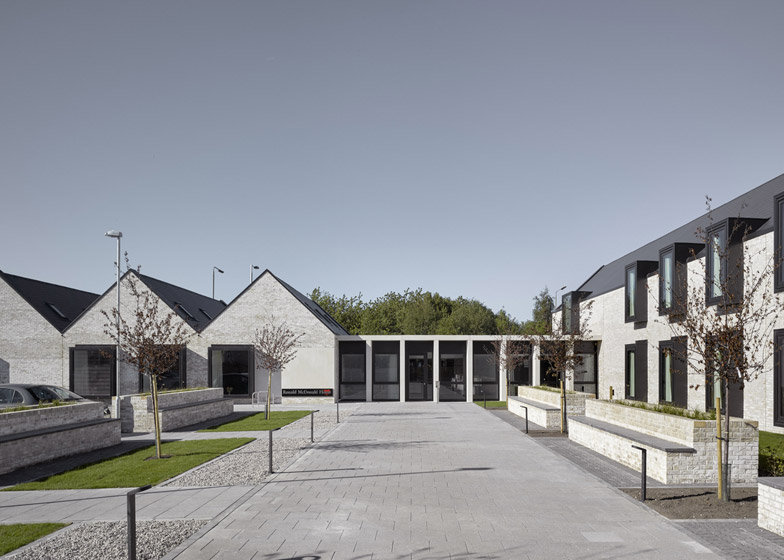Gabled brick buildings surround quiet courtyards to create an intimate and comforting environment for the families of sick children at this facility on a hospital campus in Glasgow, Scotland (+ slideshow).
The building was designed by British firm Keppie for the Glasgow branch of the Ronald McDonald House charity, which provides amenities for parents wishing to stay close to their children during long periods of treatment at the adjacent Royal Hospital for Sick Children.
The facility is situated in a corner of the South Glasgow Hospitals campus. It accommodates bedrooms and communal spaces including a lounge, kitchen and a games room, which can all be used by families.
A key aim of the project was to provide a haven with a completely different look and feel to the hospital architecture around it.
Gabled forms give the building a more domestic scale – a technique that is often used to medical buildings appear more welcoming, with examples including a cancer-care centre in Denmark and a clinic in Japan.
"There was an onus on us to try and achieve a human scale because sometimes hospitals have a really institutional feel," Keppie design director David Ross told Dezeen. "The home-from-home environment of buildings like this have to work hard to get away from those associations."
To give the building a brighter and more welcoming feel, two landscaped courtyards are situated on either side of its central section.
"We recognised that the campus was going to be quite a busy environment with buildings of different scales," said Ross. "So we wanted to create these courtyards to give the site a more domestic scale."
Gabled forms, combined with the use of rustic white brick and details that recall residential archetypes, also help to distinguish the building from the surrounding hospital architecture.
In particular, projecting bay windows that extend vertically into the roofline directly reference the pedimental features on some of the nearby houses.
The facility is bordered on one side by a busy road, so this elevation has a solid, austere presence that shields the interior spaces from traffic noise and restricts views into the site.
The road leads towards some of the city's famous disused shipyards and the shed-like facade aims to evoke this industrial heritage.
The interior environment was designed to continue the building's simple and comfortable feel, with quality materials, precise detailing and a muted palette generating a sense of cohesion.
Ceilings follow the external roofline to create an added sense of drama within the spaces. The architects also paid particular attention to concealing services and integrating lighting, so as not to disrupt the surfaces.
This attention to detail extends to the outdoor spaces, which were also designed by Keppie to achieve continuity between the internal and external environments.
"We believe the idea of relaxation comes from all the elements being considered as a whole, which includes the landscaping," said Ross.
"It's a pretty simple and relatively austere building but the consideration of how the different elements work was important to us, so the balance of where trees and shrubs are placed and the planting is a continuation of the order in the internal plan."
Ronald McDonald House Charities is a non-profit organisation established in 1989 to support families while their child receives care. Zaha Hadid is also working with the charity to create one of a series of architect-designed apartments in Hamburg.
Project credits:
Architect/interior design: Keppie
Contractor: CCG Scotland
Structural engineer: Peter Brett Associates
Quantity surveyor/employer's agent: Doig & Smith






